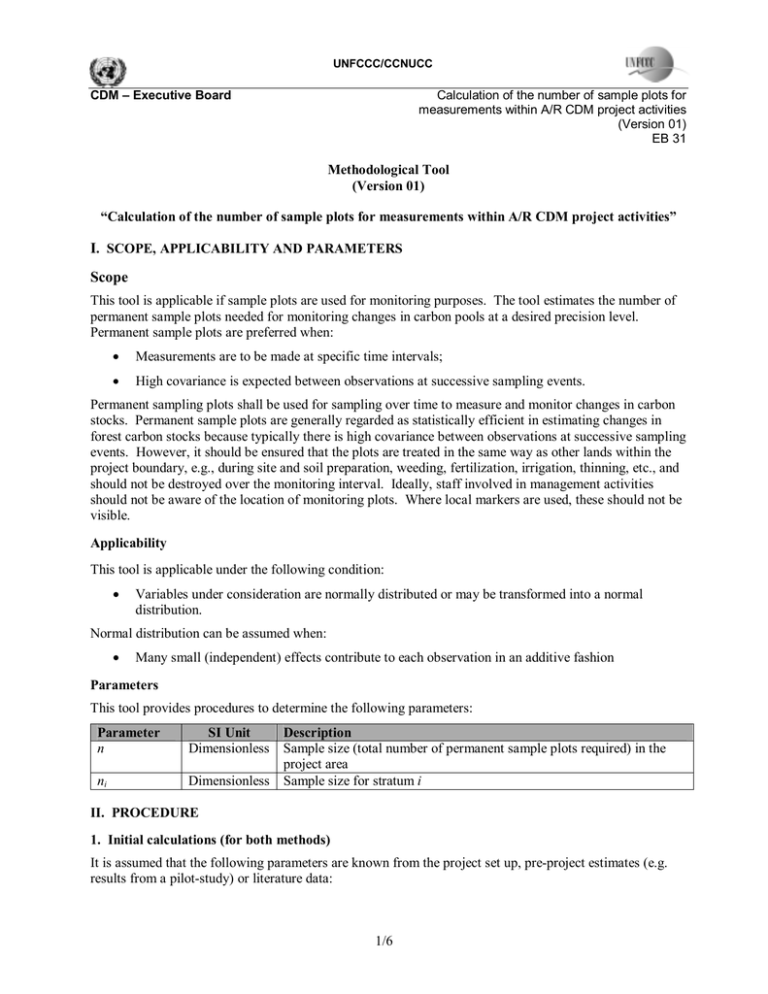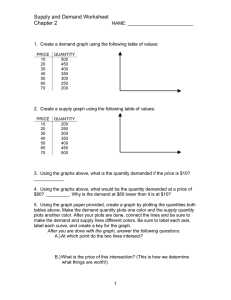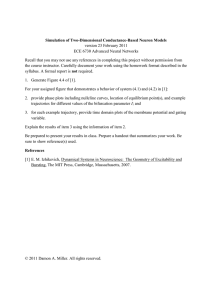Calculation of the number of sample plots for measurements within
advertisement

UNFCCC/CCNUCC CDM – Executive Board Calculation of the number of sample plots for measurements within A/R CDM project activities (Version 01) EB 31 Methodological Tool (Version 01) “Calculation of the number of sample plots for measurements within A/R CDM project activities” I. SCOPE, APPLICABILITY AND PARAMETERS Scope This tool is applicable if sample plots are used for monitoring purposes. The tool estimates the number of permanent sample plots needed for monitoring changes in carbon pools at a desired precision level. Permanent sample plots are preferred when: • Measurements are to be made at specific time intervals; • High covariance is expected between observations at successive sampling events. Permanent sampling plots shall be used for sampling over time to measure and monitor changes in carbon stocks. Permanent sample plots are generally regarded as statistically efficient in estimating changes in forest carbon stocks because typically there is high covariance between observations at successive sampling events. However, it should be ensured that the plots are treated in the same way as other lands within the project boundary, e.g., during site and soil preparation, weeding, fertilization, irrigation, thinning, etc., and should not be destroyed over the monitoring interval. Ideally, staff involved in management activities should not be aware of the location of monitoring plots. Where local markers are used, these should not be visible. Applicability This tool is applicable under the following condition: • Variables under consideration are normally distributed or may be transformed into a normal distribution. Normal distribution can be assumed when: • Many small (independent) effects contribute to each observation in an additive fashion Parameters This tool provides procedures to determine the following parameters: Parameter n ni SI Unit Dimensionless Description Sample size (total number of permanent sample plots required) in the project area Dimensionless Sample size for stratum i II. PROCEDURE 1. Initial calculations (for both methods) It is assumed that the following parameters are known from the project set up, pre-project estimates (e.g. results from a pilot-study) or literature data: 1/6 UNFCCC/CCNUCC CDM – Executive Board A i L Ai AP sti Ci = = = = = = = Calculation of the number of sample plots for measurements within A/R CDM project activities (Version 01) EB 31 total size of all strata (A), e.g. the total project area; ha index for stratum; dimensionless total number of strata; dimensionless size of each stratum i; ha sample plot size (constant for all strata); ha standard deviation for each stratum i; dimensionless cost of establishment of a sample plot for each stratum i; e.g. US $ Then: N= Ai A ; Ni = AP AP (1) Where: N Ni = maximum possible number of sample plots in the project area = maximum possible number of sample plots in stratum i 2. Method I (samples drawn without replacement) The number of sample plots is estimated as being dependent on accuracy and costs. In addition to the assumptions and parameters listed under “Initial calculations), it is further assumed that the following parameters are known from the project set up, pre-project estimates (e.g. results from a pilotstudy) or literature data: Q1 p = approximate average value of the estimated quantity Q, (e.g. aboveground wood volume per hectare); e.g. m3 ha-1 = desired level of precision (e.g. 10%); dimensionless Then: E1 = Q1 ∗ p (2) Where: E1 = allowable error of the estimated quantity Q With the above information, the sample size (minimal number of sample plots to be established and measured) can be estimated as follows: 2/6 UNFCCC/CCNUCC CDM – Executive Board Calculation of the number of sample plots for measurements within A/R CDM project activities (Version 01) EB 31 1 L L N st C ⋅ ⋅ i ⋅ ∑ N i ⋅sti ⋅ ∑ i i Ci i =1 i =1 n= 2 L N ⋅ E1 + N ⋅ (st )2 ∑ i i zα i =1 2 (3) Where: n i α zα/2 = = = = sample size (total number of sample plots required) in the project area 1, 2, 3, … L project strata 1-α is probability that the estimate of the mean is within the error bound E value of the statistic z (embedded in Excel as: inverse of standard normal probability cumulative distribution), for e.g. 1-α = 0.05 (implying a 95% confidence level) zα/2 =1.9599 The value n calculated according to the formula (2) is the minimal number of sample plots that allows the estimate of the mean to be within the error bound E with probability 1-α. This value is optimal in such sense that it minimizes sum of costs of establishment and maintenance of sample plots. The data on costs may be approximate but shall reflect relative differences of costs among strata. L ni = ∑ N ⋅ st ⋅ i =1 i 2 i Ci L E1 2 Ni ⋅ (sti ) N ⋅ z + ∑ i =1 α 2 ⋅ N i ⋅ sti Ci (4) Where: ni i α zα/2 = = = = sample size for stratum i 1, 2, 3, … L project strata 1-α is probability that the estimate of the mean is within the error bound E value of the statistic z (embedded in Excel as: inverse of standard normal probability cumulative distribution), for e.g. 1-α = 0.05 (implying a 95% confidence level) zα/2 =1.9599 3/6 UNFCCC/CCNUCC CDM – Executive Board Calculation of the number of sample plots for measurements within A/R CDM project activities (Version 01) EB 31 When no information on costs is available or the costs may be assumed as constant for all strata, then: 2 L N st ⋅ ∑ i i i =1 n= 2 L N ⋅ E1 + N ⋅ (st )2 ∑ i i zα i =1 2 (5) L ni = ∑ N ⋅ st h =1 2 i i L E1 2 ( ) N N st + ⋅ ⋅ ∑ i i zα i =1 2 ⋅ Ni ⋅ sti (6) It is possible to reasonably modify the sample size after the first monitoring event based on the actual variation of the carbon stocks determined from taking the n samples. 3. Method II (samples drawn with replacement) In addition to the assumptions and parameters listed under “Initial calculations), it is further assumed that the following parameters are known from the project set up, pre-project estimates (e.g. results from a pilotstudy) or literature data: Q2 p = approximate average value of the estimated quantity Q, on a per plot basis (e.g. m3 aboveground wood volume per plot); e.g. m3 = desired level of precision (e.g. 10%); dimensionless then: E2 = Q2 ∗ p (7) where: E2 = allowable error of the estimated quantity Q The number of permanent sampling plots for monitoring of an A/R CDM project activity may be estimated by means of the following approximate formula according to Wenger (1984)1: t n = n− L ,α E2 1 2 L L ∑ N i ⋅ sti ⋅ Ci ⋅ ∑ N i ⋅ sti i=1 i=1 Ci ⋅ Wenger, K.F. (ed). 1984. Forestry handbook (2nd edition). New York: John Wiley and Sons. 4/6 (8) UNFCCC/CCNUCC CDM – Executive Board ni = n ⋅ N i ⋅ sti L ∑N i ⋅ sti Calculation of the number of sample plots for measurements within A/R CDM project activities (Version 01) EB 31 Ci (9) Ci h =1 Where: Student’s t-distribution value for a confidence level 1-α (e.g. for α=0.05 the confidence level equals 95%) and n-L degrees of freedom Absolute value of allowable error per plot (e.g. m3) tn-L,α E2 The standard deviation of each stratum (sti) can be determined through ex ante estimates of variance of carbon stock in pools considered by the methodology. Student’s t-distribution value for 95% confidence level is approximately equal to 2 when the number of sample plot is over 30. As the first step, use 2 as the tn-L,α value and if the resulting n-L is less than 30, use the new n to get a new tn-L,α value (from statistical tables or the embedded function in Excel - inverse of Student’s t distribution) and conduct recalculation. This iterative process shall be repeated until the calculated n is stabilized. It is good practice to reasonably modify the sample size after the first monitoring event based on the actual variation of the carbon stock changes determined from taking the n samples. 4. Sample plot size (for both methods) The plot area AP has major influence on the sampling intensity and time and resources spent in the field measurements. The area of a plot depends on the stand density. Therefore, increasing the plot area decreases the variability between two samples. According to Freese (1962)2, the relationship between coefficient of variation and plot area can be denoted as follows: 2 2 CV2 = CV1 ⋅ AP1 AP2 (10) where AP1 and AP2 represent different sample plot areas and their corresponding coefficient of variation (CV). Thus, by increasing the sample plot area, variation among plots can be reduced permitting the use of small sample size at the same precision level. Usually, the size of plots is between 100 m2 for dense stands and 1000 m2 for open stands. 5. Determining plot location (for both methods) 1. The permanent sample plots shall be located systematically with a random start, which is considered good practice in GPG-LULUCF. This can be accomplished with the help of a GPS in the field. The geographical position (GPS coordinate), administrative location, stratum and stand, series number of each plots shall be recorded and archived. 2. Ensure that the sampling plots are evenly distributed in the stratum. If the stratum consists of sites that are geographically separated, then the plots to be allocated to each site should be in proportion of the site area to the total stratum area with rounding of the fractions. For example, if one stratum consists of three geographically separated sites, then it is proposed to: 2 Freese, F. 1962. Elementary Forest Sampling. USDA Handbook 232. GPO Washington, DC. 91 pp 5/6 UNFCCC/CCNUCC CDM – Executive Board Calculation of the number of sample plots for measurements within A/R CDM project activities (Version 01) EB 31 • Divide the total stratum area by the number of plots, resulting in the average area represented by each plot; • Divide the area of each site by this average area per plot, and assign the integer part of the result to this site, e.g., if the division results in 6.3 plots, then 6 plots are assigned to this site, and 0.3 plots are carried over to the next site, and so on. 3. To avoid bias in the location of plots, their location shall be marked on a map prior to establishment. This can be done using a simple grid based on the number of plots required. In most cases plots are located away from the edge of the plantation to avoid the edge effect. Check for alignment of boundary and ensure that entire sample plot is within the strata. Use Geographic Information System to locate the sample plots inside 10 m from the project boundary. 6/6




